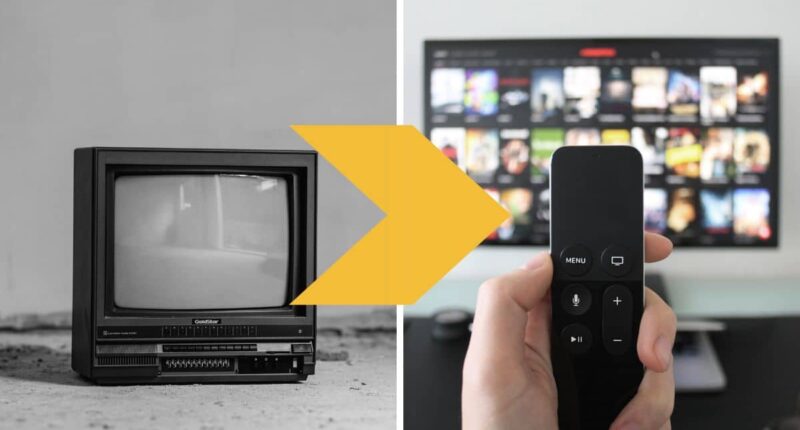Since its humble beginnings as a flickering black and white box in living rooms across the world, television has undergone a remarkable evolution. It has grown from a limited and local medium to a global force that captivates audiences with its diverse array of content. From the early experiments and breakthroughs in technology to the advent of streaming services, the journey of television has shaped our culture, transformed our entertainment habits, and revolutionized the way we consume media. In this article, we embark on a fascinating exploration of the history of television, tracing its remarkable trajectory from its earliest inception to the era of streaming services.
The History of Television: From Black and White to Streaming Services
The Birth of Television
Television history dates back to the late 19th century when inventors and engineers began experimenting with the transmission of moving images. However, it wasn’t until the early 20th century that significant breakthroughs were made. The first public demonstration of electronic television took place in 1927. Philo Farnsworth, an American inventor, showcased a working electronic television system that used cathode ray tubes (CRTs) to display images. Farnsworth is often credited as the inventor of electronic television.
The Era of Black and White TV
The advent of black and white television in the 1930s marked a significant milestone in the evolution of this medium. People were captivated by the ability to witness events unfold in their living rooms, as television broadcasting expanded and improved. The popularity of black and white TV grew rapidly, becoming a staple in households around the world.
During the era of black and white TV, families would gather around the television set, eagerly tuning in to watch their favorite shows and share collective moments of entertainment and cultural experiences. The black and white screen, despite its limitations, had the power to ignite imaginations and transport viewers into a whole new world of storytelling.

Television Technology and Advancements
Television technology continued to evolve, leading to several important advancements. One such breakthrough was the introduction of colour television in the 1950s. Colour broadcasts provided a more immersive and engaging viewing experience, bringing a new level of realism to the screen. This innovation revolutionized the industry, paving the way for future developments.
The introduction of remote controls in the 1950s allowed viewers to conveniently change channels and adjust settings without having to get up from their seats, further enhancing the user experience and solidifying television’s place as a staple in households around the world.
The Television Timeline
Throughout the years, television witnessed numerous transformative moments. The timeline of television is rich with landmark events, including the first live satellite transmission, the introduction of remote controls, the rise of cable television, and the emergence of high-definition (HD) broadcasts.
- 1927: Philo Farnsworth demonstrates the first working electronic television system.
- 1936: The BBC begins regular high-definition television broadcasts.
- 1948: The Federal Communications Commission (FCC) allocates television frequencies in the United States.
- 1950s: The introduction of color television begins, initially in limited capacity.
- 1960s: The first satellite television transmissions enable international broadcasting.
- 1970s: The advent of cable television brings a wider range of channels to viewers.
- 1980s: The introduction of VCRs (Video Cassette Recorders) allows viewers to record and playback television programs.
- 1990s: The rise of digital television leads to improved picture and sound quality.
- 2000s: High-definition television (HDTV) becomes widely available, offering enhanced viewing experiences.
- 2006: YouTube is launched, allowing users to share and watch videos online, including television content.
- 2010s: Streaming services such as Netflix, Hulu, and Amazon Prime Video gain popularity, revolutionizing the way people consume television content.
- 2013: Ultra HD or 4K television is introduced, providing even higher resolution and more detailed images.
- 2015: Virtual Reality (VR) headsets begin to incorporate television content, offering immersive viewing experiences.
- 2020s: The emergence of Over-the-Top (OTT) platforms, including Disney+, Apple TV+, and HBO Max, further diversifies the streaming landscape.
- 2021: The launch of Next-Gen TV (ATSC 3.0) brings advanced features such as 4K resolution, HDR (High Dynamic Range), and interactive capabilities to over-the-air television broadcasts.
The digital switchover in the late 20th century, which replaced analog signals with digital transmissions, revolutionized television broadcasting and paved the way for enhanced picture and sound quality. Each milestone brought television closer to what we know it as today.

The Television Industry and Broadcasting
Television’s rise to prominence led to the growth of a thriving industry. Networks and channels became integral players in delivering content to viewers. As the number of television sets in households multiplied, broadcasters faced the challenge of providing diverse programming to cater to a wide range of interests.
Television became a powerful medium for news, entertainment, and cultural dissemination. The globalization of television broadcasting allowed for the exchange of ideas, cultures, and perspectives on a global scale, fostering cross-cultural understanding and enriching the collective human experience.
The Television Revolution: Streaming Services
The turn of the 21st century brought about a seismic shift in how we consume television. Streaming services emerged as a disruptive force, forever changing the landscape of the industry.
With the advent of high-speed internet and improved bandwidth, viewers gained access to an abundance of on-demand content. Streaming platforms such as Netflix, Amazon Prime Video, and Hulu revolutionized the way we watch television, enabling us to binge-watch entire seasons and discover a multitude of shows and movies.
The rise of streaming services gave birth to a new era of original content production, with platforms like Netflix and Amazon investing heavily in creating their own exclusive shows and movies, captivating audiences with fresh and innovative storytelling.

Cord-Cutting and the On-Demand Revolution
Cord-cutting, the act of cancelling traditional cable or satellite subscriptions in favour of streaming services, became a widespread trend. Viewers embraced the flexibility and cost-effectiveness of on-demand TV, freeing themselves from rigid programming schedules and advertisements. This shift in consumer behaviour led to a dramatic transformation in the television landscape, prompting traditional broadcasters to adapt to the changing preferences of their audience.
The Future of Television Internet Television
As technology continues to advance, the future of television is poised for further innovation. The emergence of Internet television, which combines the power of the internet with the traditional television medium, holds immense potential. With the advent of 5G networks, augmented reality (AR), and virtual reality (VR), viewers can expect even more immersive and interactive television experiences in the years to come.
The integration of artificial intelligence (AI) and machine learning algorithms in Internet television platforms will enable personalized content recommendations and seamless user experiences, enhancing the way we discover and engage with our favorite shows and movies.
Also Read: The Evolution of Social Media



